John Sunumu: Nature will respond to climate change in the future in a self-stabilising way, as it always has in the past.
Willie Soon: The first order of business is that the null hypothesis is that the climate change we observe is due to natural variability.
Bob Carter: IPCC climate policy (Plan A) – to prevent hypothetical human-caused climate change by reducing CO2 emissions – hasn’t worked and won’t work. Policy Plan B needs to be that countries develop their own capacity to prepare for and adapt to real, natural climate change; they will then be well positioned to cope with hypothetical (human-caused) climate change, should any eventuate.
Lord Christopher Monckton: There was no climate crisis, there is no climate crisis and there will be no climate crisis. The correct solution to global warming is to have the courage to do nothing.
The first plenary speaker of the final day of the Heartland-2 New York climate conference was Dr. John Sununu, Chief of Staff for President George Bush Snr. between 1989 and 1992. From that unique perspective he offered an incisive commentary on current environmental activism, including particularly that directed towards global warming. 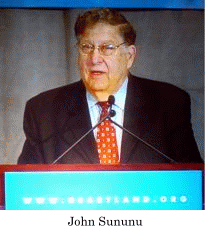
Dr Sununu advised his audience to recognize that the climate change issue will never go away, no matter how much the false alarmism of global warming is exposed. The reason is that global warming is not the real target, but just a convenient demon around which anti-growth and anti-development activism can be mounted. Early demons for the same cause after the second world war were, first, the declared “population crisis”, and then the global cooling alarmism that became prevalent in the 1970s. In turn, climate cooling alarmism transmuted into the dangerous warming cult of the 1990s and beyond.
The most significant tactical weapon that was developed along this historic path of anti-growth agitation was the use of virtual reality computer models to generate alarm. Thus the real predecessor to the present situation was the Club of Rome “we will run out of resources” exercise, which was the first large-scale, environmental, computer modelling project to base its alarms not on empirical data, but on a computer model that was predestined to give a desired result. This same predestination applies to the current IPCC computer models, which are now far too complex to be checked or debated in the public forum, and which carry great authority. Accordingly, they have become a powerful weapon in the armoury of anti-growth environmental groups.
Dr Sununu recalled a White House briefing that he received from alarmist scientists around 1990, when only the first primitive climate models were available – which did not include ocean to atmosphere interactions. Ever since, development of these faulty, but now much more sophisticated, models has continued in order to drive a predetermined climate alarmism. In consequence, the modellers have captured major parts of the funding streams now directed into global warming research, which in the US alone may total as much as $10 billion/year. “Despite this”, said Dr Sununu, the current models remain “predestined …. and are extremely far away from being able to handle the reality of nature. Nature will respond to climate change in the future in a self-stabilising way, as it always has in the past”.
In closing, Dr Sununu offered some advice towards winning over public opinion in a way that will influence policy makers. Unfortunately the press stands in the way of this process, and thrives on reinforcing climate alarmism. “I am often asked “Is the press biased or ignorant”, said Dr Sununu, “and I reply “they certainly are”. Nonetheless, science must today be presented in non-technical ways which can be understood by both your neighbour and by policy makers – “If we don’t give the press sound bites, they won’t use it”, Dr Sununu said. Honest science, good science and valid science is the necessary basis for public policy.
The second breakfast plenary speaker, Dr Willie Soon, is a solar astrophysicist based at Harvard-Smithsonian Center for Astrophysics. Dr Soon commenced by noting, refreshingly, that “The first order of business is that the null hypothesis is that the climate change we observe is due to natural variability”. 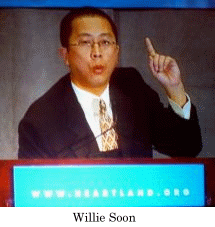
Dr Soon’s talk demonstrated that the IPCC’s 4AR discussion of solar forcing is inadequate and largely political. For example, in its dismissal of the importance of solar effects on climate the IPCC completely misrepresents the work of Milutin Milankovitch. Milankovitch showed that the climatic effect of the earth’s changing orbit – which demonstrably plays an important role in long-term climate change – has little to do with changes in total solar insolation (as implied by the IPCC) and everything to do with the changing distribution of that radiation across the planet (as ignored by the IPCC). When Ralph Cicerone, President of the National Academy of Science supported the IPCC’s view by stating that a sun-induced climate change theory is no longer viable, he simply demonstrated how misinformed he is.
Dr Soon also described the empirical test as to whether extra carbon dioxide will produce extra warming that is conducted in Salt Lake City, and other similar cities, every winter. There, a winter CO2 dome attains CO2 levels up to 500 ppm, as compared to the present background atmospheric level of 380 ppm. Yet no discernible enhanced warming is present in the measured temperature curve for Salt Lake City. It follows that the worldwide rush to inhibit CO2, at huge cost, will have no effect on future climate whatsoever. “The role of CO2 in the climate system is just miniscule”, Dr Soon said.
Four parallel sessions of papers were again offered in the main programme on the third day of the conference. Science and policy bites from those few lectures that I was able to attend were as follows.
George Taylor (Oregon State University), discussing the Pacific Decadal Oscillation, concluded that it is a permanent feature of the world climate system, has a roughly 50 year periodicity, and ties in closely with ENSO phases and variation in global temperature over the last century.
David Douglass (University of Rochester) documented evidence for significant climate “step” shifts in 1958, 1973 (Great Pacific Climate Shift) and 1999, and concluded that these shifts placed a limitation on climate predictability, and that any climate forcing from CO2 is small. 
Joanne Nova (author of The Skeptics Handbook, Perth, Australia) presented a merciless analysis of the shortcomings of the science media in presenting material about global warming. New Scientist Magazine, in particular, was shown to display strong bias towards science results that reinforce an alarmist view of global warming.
The conference terminated with a lunchtime plenary session. There, the third plenary speaker of the day was Dr Bob Carter, a geologist and palaeoclimate scientist from Queensland, Australia.
Dr Carter mostly discussed climate policy matters. He compared the relative merits of the current policy of trying to “prevent global warming” by reductions of carbon dioxide emissions (Plan A), with the merits of adapting to climate change as and when it occurs (Plan B).
The IPCC’s plan of prevention has been trialled by combining regulation under the Kyoto Protocol with the dissuasive powers of a carbon dioxide trading system, for instance in Europe. 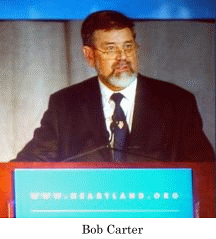 From this trial it is apparent that the CO2 reductions agreed to under Kyoto, even were all to be achieved, will make no measurable difference to future temperature. Also, the experience of early mover countries on carbon dioxide taxation, such as Norway, is that at reasonable tax levels of $15-25/tonne no reduction in emissions is achieved, Norway’s having increased 15% since 1990. Thus Plan A doesn’t work, can’t work and won’t work; it is already a dead parrot.
From this trial it is apparent that the CO2 reductions agreed to under Kyoto, even were all to be achieved, will make no measurable difference to future temperature. Also, the experience of early mover countries on carbon dioxide taxation, such as Norway, is that at reasonable tax levels of $15-25/tonne no reduction in emissions is achieved, Norway’s having increased 15% since 1990. Thus Plan A doesn’t work, can’t work and won’t work; it is already a dead parrot.
Meanwhile, Nature has delivered powerful messages recently as to the danger of natural climate change, via Hurricane Katrina in 2005 in USA, and devastating bushfires and floods in Australia in 2009. It is obvious that countries need to be better prepared to understand, cope with and adapt to the damaging effects of these and other natural climatic events and trends. Just like earthquakes and volcanic eruptions, major climatic events are unpredictable long in advance and unstoppable once started.
The appropriate response – and climate policy plan B – is to adapt to such events when and as they occur. Dr Carter also argued that adaptation to climate events is intrinsically local or regional in nature, for climate risks vary widely with geography. Importantly, a country that has prepared to deal with the wide vagaries of natural climate change within their territory is, by that very fact, positioned to deal with any human-caused climate change if and when it occurs.
The fourth plenary speaker was John Theon, a retired senior atmospheric scientist from NASA. 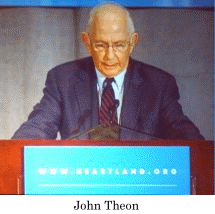 Dr Theon used to be boss of notorious climate alarmist Dr James Hansen, and commenced his talk by observing wryly that “Perhaps I should have kept a closer eye on him!”
Dr Theon used to be boss of notorious climate alarmist Dr James Hansen, and commenced his talk by observing wryly that “Perhaps I should have kept a closer eye on him!”
Dr Theon recounted in fascinating fashion some of the ways in which the study of climate change occurred throughout his career. He was particularly incisive about the way in which models are misused. “Too many modellers tune their models”, he said, “if you have the answer before you begin, you can play with the model to get what you want”. Dr Theon concluded: “Only religion requires faith in its believers. Science cannot be based on faith. It must be based on facts alone”.
The Heartland-2 climate conference was brought to a close with a rousing closing address by Lord Christopher Monckton, former science advisor to British Prime Minister Margaret Thatcher.
Lord Monckton discussed some of the deliberately misleading myths about climate change that are propagated by warming alarmists, listing them as:
“Global warming is happening now” – it’s actually cooling.
“Global warming is getting worse” – it’s actually getting better.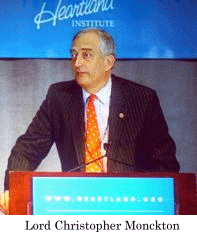
“Arctic sea ice is disappearing” – in fact, there is no discernable trend in winter sea ice area over the last 30 years.
“Antarctic sea ice is disappearing” – in fact, the area of sea-ice around Antarctica reached a 30 year record high in 2007.
“The Great Barrier Reef is being damaged by global warming” – in fact, there is no trend in the sea surface temperature of the reef over the last 40 years.
“Hurricanes are being made worse by global warming” – rather, the accumulated cyclone energy index recorded its lowest value in the last 30 years in Oct. 2008.
Lord Monckton also commented on recent opinion polls that show a strong swing of public opinion away from climate alarmism: “Every opinion poll shows that public opinion is cooling as fast as the climate itself”, he said.
Lord Monckton concluded with some comments that will serve well as an epitaph for the entire Heartland-2 climate conference. “There was no climate crisis, there is no climate crisis and there will be no climate crisis”, he said. “The correct solution to global warming is to have the courage to do nothing”.
A strong vote of thanks is due to the Heartland Institute, and to its CEO, Joe Bast, for having again convened an outstanding conference at which rational discussions of the science, economics and policy of climate change were presented and discussed in a dignified and disinterested way. All participants in the conference must surely have left New York with a lightened heart, knowing that independent scientific approaches are at last starting to lay waste to the scourge of public climate alarmism.
Bob Carter
UPDATES:
Background to Heartland-2 here
Heartland-2: session one here
Heartland-2: session two here
 Sign In
Sign In 0 Items (
0 Items ( Search
Search








